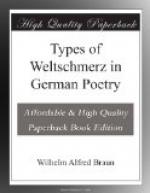In spite of his deep and persistent Weltschmerz, Hoelderlin rarely gives expression to a longing for death. This forms so prominent a feature in the thought of other types of Weltschmerz, for instance of Lenau and of Leopardi, that its absence here cannot fail to be noticed. It is true that in his dramatic poem “Der Tod des Empedokles,” which symbolizes the closing of his account with the world, Hoelderlin causes his hero to return voluntarily to nature by plunging into the fiery crater of Mount Etna. But Empedokles does this to atone for past sin, not merely to rid himself of the pain of living; and thus, even as a poetic idea, it impresses us very differently from the continual yearning for death which pervades the writings of the two poets just mentioned. Leopardi declared that it were best never to see the light, but denounced suicide as a cowardly act of selfishness; and yet at the approach of an epidemic of cholera, he clung so tenaciously to life that he urged a hurried departure from Naples, regardless of the hardships of such a journey in his feeble condition, and took refuge in a little villa near Vesuvius. Hoelderlin’s Weltschmerz was absolutely sincere.
Numerous passages might be quoted to show that Hoelderlin’s mind was intensely introspective. This is true also of Lenau, even to a greater extent, and may be taken as generally characteristic of poets of this type. The fact that this introspection is an inevitable symptom in many mental derangements, hypochondria, melancholia and others, indicates a not very remote relation of Weltschmerz to insanity. In Hoelderlin’s poems there are not a few premonitions of the sad fate which awaited him. One illustration from the poem “An die Hoffnung,” 1801, may suffice:
Wo bist du? wenig lebt’
ich, doch atmet kalt
Mein Abend schon. Und
stille, den Schatten gleich,
Bin ich schon hier; und schon
gesanglos
Schlummert das schau’rende
Herz im Busen.[74]
It is impossible to read these lines without feeling something of the cold chill of the heart that Hoelderlin felt was already upon him, and which he expresses in a manner so intensely realistic and yet so beautiful.
Having thus attempted a review of the growth of Hoelderlin’s Weltschmerz and of its chief characteristics, it merely remains to conclude the chapter with a brief resume. We have then in Friedrich Hoelderlin a youth peculiarly predisposed to feel himself isolated from and repelled by the world, growing up without a strong fatherly hand to guide, giving himself over more and more to solitude and so becoming continually less able to cope with untoward circumstances and conditions. Growing into manhood, he was unfortunate in all his love-affairs and as though doomed to unceasing disappointments. Early in life he devoted himself to the study of antiquity, making Greece his hobby, and thus creating for himself an ideal world which existed only in his imagination, and taking refuge in it from the buffetings of the world about him. He was a man of a deeply philosophical trend of mind, and while not often speaking of it, felt very keenly the humiliating condition of Germany, although his patriotic enthusiasm found its artistic expression not with reference to Germany but to Greece. As a poet, finally, his intimacy with nature was such that nature-worship and pantheism became his religion.




